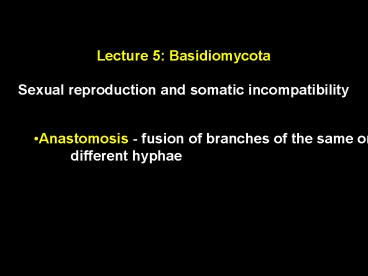Lecture 5: Basidiomycota - PowerPoint PPT Presentation
1 / 18
Title:
Lecture 5: Basidiomycota
Description:
dikaryon formation occurs in single, ... One of the major challenges facing a mycelium is encountering ... Dikaryons encounters other dikaryons and behave as an ... – PowerPoint PPT presentation
Number of Views:1942
Avg rating:3.0/5.0
Title: Lecture 5: Basidiomycota
1
Lecture 5 Basidiomycota Sexual reproduction and
somatic incompatibility
- Anastomosis - fusion of branches of the same or
- different hyphae
2
- 7) Mating event
- Fusion of monokaryons
- formation of dikaryon
- sexual compatibility
- recognition and fusion
- of monokaryons
- controlled by mating
- type genes (MAT)
- 3 mating systems
- homothallic
- heterothallic
- secondary homothallic
3
- Homothallic, heterothallic, secondary
homothallic - homothallic
- dikaryon formation occurs in single,
self-compatible thallus - 25 of all species of basidiomycetes
- heterothallic
- self-sterile (self-incompatible) individuals
- requires the union of two, unique compatible
thalli - 75 of all species of basidiomycetes
4
- Mating type genes (MAT genes)
- a MAT locus consists of few to several tightly
linked genes - Unifactorial (bipolar)
- - one locus or factor (A)
- - requires 2 unlike alleles for mating type
compatibility - - 25 of heterothallic species
- Bifactorial (tetrapolar)
- - two unlinked loci or factors on different
chromosomes - (A and B)
- - requires 4 unlike alleles for mating type
compatibility - - 75 of heterothallic species
5
- Unifactorial (bipolar)
- one locus (unifactorial) controls mating
- two different alleles (bipolar) required for
- compatibility of nuclei
- Hymenomycetes can have from
- tens to hundreds of alleles/locus
- (A is locus, numbers, e.g., 1,2,3... are alleles)
- A1 X A2 (karyogamy) ----gt A1A2 (meiosis)
- ----gt A1 A2 (spores)
6
- Bifactorial (tetrapolar)
- two loci (factors) control mating
- four different alleles (tetrapolar) - two at
both factors - - required for compatibility of nuclei
- numerous alleles/locus as in unifactorial
systems - A1B1 X A2B2 (karyogamy) ----gt A1B1A2B2 (meiosis
- crossingover) ----gt A1B1, A2B2, A1B2, A2B1
7
Mating type systems are usually determined in
sibling spore mating. For example, 10 spores
from a single basidiocarp are germinated to
establish 10 monokaryons. These 10 monokaryons
are then paired against each other in all
possible combinations (10 X 10 100). Those
monokaryons that possess compatible mating type
alleles will fuse to form dikaryons. Those
monokaryons that do not possess compatible mating
type alleles will fail to form dikaryons. The
major limiting factor with this approach is that
the spores of many species of basidiomycetes do
not germinate in culture.
8
Sibling spore mating
Bipolar/ Unifactorial 5050 (CI)
Tetrapolar/bifactorial 2575 (CI)
C compatible, I incompatible
9
- Ultimate function of A B alleles discerned via
partial - compatibility crosses
- fusion between A1B1 X A1B2 (identical A alleles)
- no clamp connections formed
- fusion between A1B1 X A2B1 (identical B alleles)
- clamp connections formed but no migration of
nuclei
10
- Secondary homothallic
- fungi that produce binucleate basidiospores
- contain two haploid nuclei with compatible mating
type alleles - basidiospore germinates directly into a dikaryon
- no true monokaryotic stage to life cycle
- superficially resembles a homothallic species
A1
A2
A1
A1
A1
A2
A2
A2
11
- Somatic Incompatibility
- fusion of dikaryons
- self vs. nonself recognition
- controlled by het genes
- multigenic and multiallelic
- function in the dikaryotic state
12
- A.H.R. Buller - unit mycelium
- mycelia are cooperative genetic mosaics
- Rayner - individualistic mycelium
- mycelium is more than simple, additive
assemblage of hyphae - Self vs. nonself reactions - individual
identities - Mycelium capable of indeterminate growth
- One of the major challenges facing a mycelium is
encountering - other mycelia of the same or similar species
13
Things a dikaryotic mycelium must do
migrate between discontinuous nutrient deposits
capture resources compete with
neighbors respond to changes in
microenvironment form symbioses
sporulate
14
- Self-fusions
- fusion between genetically identical hyphae
- combination of hyphae into aggregates or somatic
tissues - e.g. rhizomorphs of Armillaria, extend at a rate
faster - than the mycelium
- specialized function (division of labor)
- absorptive components and sinks
- translocation of nutrients along tugor
gradients controlled - by nutrient supply and water potential
15
- Mechanisms that prevent or restrict nonself
anastomosis - somatic incompatibility (SI) non-self rejection
- multiple mechanisms and outcomes
- SI distinguish between pre- and post- fusion
- rejection results in the death of fusion
compartments and - associated hyphae
- septal maintenance plugging of septa thus
not allowing - physiological access
16
- SI in basids
- occur between dikaryons that are heterokaryotic
- genetic system is polygenic and multiallelic and
may generate - innumerable individual specificities analogous
to human - HLA histocompatibility system
- in culture results are demarcation zones or
barrage lines between - colonies compared against control self-pairings
- often observed in nature e.g., spalted wood,
inhibition lines - among wood decay fungi
17
2 spores germinate to produce monokaryons Primary
mycelia fuse to produce dikaryon (mating)
Dikaryons encounters other dikaryons and behave
as an unique individual (somatic
incompatibility) Unique somatic compatible
units, i.e., unique secondary mycelia, called
genets or clones Two somatically incompatible
secondary mycelia may go on to produce
basidiospores and primary mycelia that are mating
compatible.
18
How would you determine how many individuals of
the same species exist in a given area?































